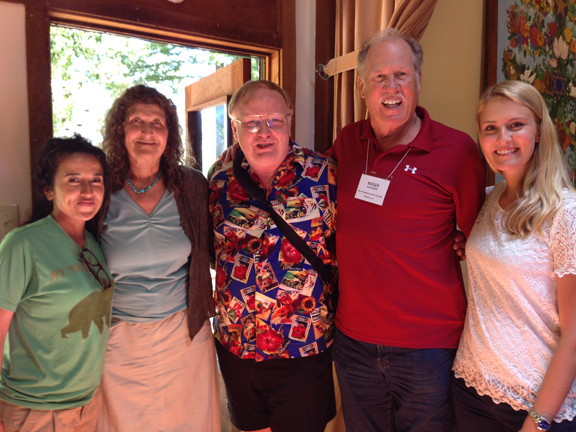Pictured: Karen Burbano (Google eTeam), Arlene Blum (Founder, Executive Director, Green Science Policy Institute), Alex Stone (Senior Chemist, Safer Chemical Alternatives, Washington Dept. of Ecology), Roger McFadden (Vice President, Senior Scientist, Staples), Therese Holgrom (Chemical Team Leader, IKEA of Sweden) at Blue Mountain Retreat II
What an honor to spend four days in the Santa Cruz mountains with 22 thought-leaders from around the country (and one from Sweden representing IKEA) all of whom are passionately dedicated to the reduction of toxic chemicals in our environment.
Toxins are pervasive and many are persistent, meaning they no matter what we do, they aren’t going away any time soon. Given this reality, I can still say there is good news. Largely due to the commitment and influence of the individuals who were present, change is afoot.
This was the second annual gathering of its kind, The Blue Mountain Toxic Reduction Retreat II. It was organized by Arlene Blum and the staff at the Green Science Policy Institute.
Here is the Blue Mountain Mission statement:
“Our mission is to ensure that consumer products are free from chemicals which harm human health and the environment. We question the use of chemicals from classes of concern: halogenated antimicrobials, stain repellants, and flame retardants; some solvents; endocrine disrupting plasticizers; and some heavy metals. By limiting the use of whole classes of harmful chemicals, rather than addressing them one at a time, we can avoid the current cycle of “regrettable substitutions.” Also, we will help build and share the expertise required to make healthy green chemistry the model for future product and process development.”
“The Green Science Policy Institute provides unbiased scientific information to government, industry, and non-governmental organizations to facilitate more informed decision-making about chemicals used in consumer products in order to protect health and environment world-wide.” http://greensciencepolicy.org/
Arlene Blum, environmental scientist, author and celebrated mountaineer (second from left in photo), is to be honored October 9 as this year’s recipient of the Benjamin Ide Wheeler Medal by the Berkeley Community Fund for her efforts to eliminate harmful chemicals from our homes and environment. Arlene is credited with removing cancer-causing flame retardants from children’s sleepwear in 1977, and her more recent work as Founder and Executive Director of the Green Science Policy Institute is no less impactful. Arlene, who also led the first American climb to the summit of Annapurna I, is a model of what one passion-driven woman can do.
Each of the attendees made a 15-minute presentation on their area of expertise. The presentations were followed by small breakout exercises and discussion with whole group on each topic. This went on for four intense days and night. There were no boring moments. The group was a balanced cross-section of exceptionally bright, passionate, and enlightened individuals and included leaders from science, business, academia, and NGOs. Then there was one category with just one person: Communications. I presented communication skills for science. Though I haven’t worked with many scientific institutions, I have helped so many clients communicate complex technologies. I see a distinct similarity in the typical approach. Both engineers and scientists have a tendency to jump right into explaining before authentically engaging. They consequently can easily lose their audience. You see it everywhere. Websites written by engineers who can’t imagine anyone being able to lead their communication effort besides a geek. In both scientific and technical circles, there seems to be a pervasive belief that any copy that is not a hard fact is fluff and, therefore, should be edited out. If ever I felt I was on this planet for a reason, it was here.
The most important part.
I have to admit, was more than a little afraid of what I would learn about harmful chemicals in our environment. And my fears were not unfounded. But, as a person who, at the core, cares about these things, and given I’m a communications professional, there was no option for me accept when invited.
What I learned among the Redwoods has changed my view of the world. And though the state of things is not pretty, I came away feeling inspired and filled with hope. Like Annapurna, the mountain before us is, indeed, steep. Only together can we climb to new heights. These leaders, working from varied positions of influence, have left the base camp. Our responsibility then, is to educate ourselves and others so that we might all make informed choices not only for our own optimal health but to influence policy for the health of others, and our planet.
Six Classes, a brain child of Arlene Blum, is a brilliant communication strategy that makes chemistry and scientific concepts accessible to everyone.
And each journey begins with a step. Start by reading this page: http://www.sixclasses.org/#section-topics
July 2014
Santa Cruz, California


